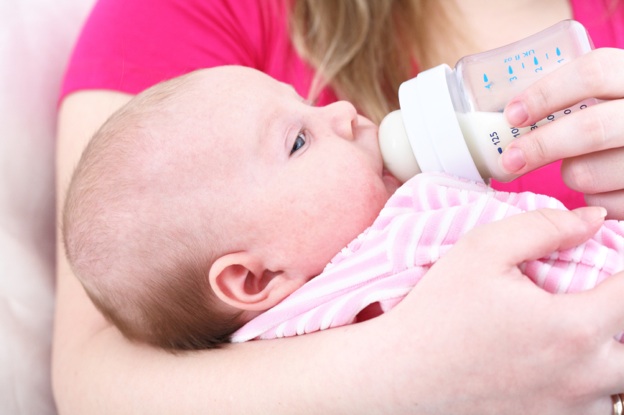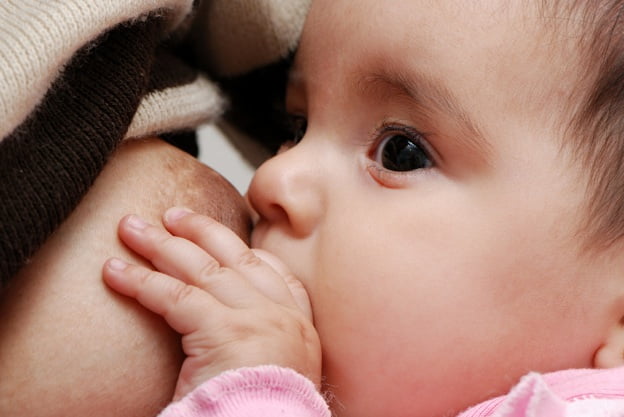SingaporeMotherhood | Baby & Toddler
August 2012
Combining Breast & Bottle

Although many Singaporean mothers begin breastfeeding at birth, exclusive breastfeeding rates generally decrease as newborns get older. This does not happen only in Singapore; it is consistent worldwide.
• 22 per cent of babies were exclusively breastfed at one month, 18 per cent at two months and 7 per cent at four months, according to the International Baby Food Action Network’s 2011 report.
• Echoing these trends, the Health Promotion Board’s National Breastfeeding Survey in 2011 found that 50 per cent of mothers in Singapore continue to breastfeed exclusively after being discharged from the hospital, while 30 per cent continue for two months. Numbers decrease further at four months.
[banner][/banner]
Why should this be so? After all, direct, exclusive breastfeeding offers many more benefits compared to bottle-feeding expressed breastmilk.
These benefits include:
• Mother-baby bonding
• Jaw, facial and speech development in your breastfeeding baby
• Anti-body protection. If your baby comes in contact with a pathogen, your body responds to signals in his saliva by creating specific antibodies in your breastmilk for that pathogen within a few hours. Expressed breastmilk from an earlier date cannot provide this protection.
• Constant nutrient content. Nutrients are lost when you handle, store, then warm up the expressed breastmilk.
Unfortunately, not all mothers are fortunate enough to be able to latch on every single time, or for an extended period of time. You may decide to bottle-feed expressed breastmilk or feed complementary foods alongside breastfeeding if you return to work, have to be separated from your nursing baby for periods of time, or if for any reason, you do not want to breastfeed directly.
How can you support a continued breastfeeding relationship, while introducing bottles?
How can you maintain a close relationship with your baby while bottle-feeding?
Bottles In The Early Weeks?
Bottles should be introduced only after breastfeeding has been established, after at least four weeks of age. This is why:
• During the days after birth, a newborn is learning to breastfeed. Babies suck differently from the breast and a bottle nipple. Introducing a bottle while your baby is still learning may cause nipple preference!
• Your baby may come to prefer milk flow from the bottle.
• In the post-birth days, your body is setting up the internal ‘infrastructure’ via a network of hormone-receptor cells, for future milk production. Your baby’s suckling is the best way to encourage the growth of this network during the early days.
If your baby needs to receive milk through means besides breastfeeding, you can use a spoon, a cup or a syringe.
You may be advised to introduce a bottle for fear that your baby may refuse one later. Or postnatal helpers may suggest bottle-feeding the baby while you rest. However, a baby may begin preferring the bottle after only a few bottle-feeds. We cannot know for sure, hence it is best to avoid bottles initially.
Breastfeeding As The Model
If you have chosen to use a bottle after four weeks, think of bottle-feeding in ways that mimic breastfeeding.
CHOICE OF BOTTLE NIPPLE
Choose a bottle nipple that most closely resembles the breast. Breastfeeding experts and lactation consultants Diana West and Lisa Marasco suggest choosing nipples that are round with wide bases.
If there is a large mismatch between your nipple shape and that of the bottle nipple, challenges are more likely to arise. Choose a slow-flow nipple for your breastfed baby.
BABY-LED BOTTLE-FEEDING
Breastfeeding works best by following baby’s feeding cues such as rooting. Bottle-feeding can also occur in response to your baby’s cues, not according to a schedule.
Traditional bottle-feeding methods involve feeding a fixed amount of milk, to be downed as quickly as possible. Instead, encourage caregivers to let a bottle-feed take up to 20 minutes, watching for signs of fullness in the baby.
A baby who is content and has dozed off need not be awakened by tickling his cheek or rolling the teat around in his mouth, to ‘finish’ the remaining feed.
These strategies ensure that your baby’s intake corresponds with his needs and his size, preventing overfeeding, a distended stomach or under-feeding.
LATCH
When latching your baby onto the bottle nipple, touch his lower lip against the nipple base, with the nipple pointing upwards and lying across his lips. When he opens wide as a yawn, roll the nipple deeply into his mouth. His lips should be rolled slightly outwards.
This method of latching encourages a wide-open latch onto the nipple base, as if your baby is latching into your breast. So your baby is encouraged to take in a mouthful of teat, as he would when breastfeeding.
FLOW
During a breastfeed, the flow of milk is influenced by your letdown; breastmilk sprays at the beginning of a letdown, slowing to a trickle later. It once again increases to a gush with another letdown. With a bottle, flow remains steady throughout.
Paced bottle-feeds are in keeping with the rhythmic flow of breastmilk. After four to five sucks, withdraw the bottle nipple. Keep the nipple in contact with your baby’s lower lip, and roll it back into his mouth when he is ready.
POSITIONING
You can use breastfeeding positions while bottle-feeding. This may mean holding your baby in a cradle position, with his cheek against your breast and the bottle nipple where your own nipple would be.
Just as you breastfeed from either breast, bottle-feed your baby while holding him facing right and left. Try switching directions partway through a feed. This facilitates eye development, and prevents him from developing a preference for nursing from one side.
Closeness Through Bottle-feeding
In their book Attached At The Heart Attachment Parenting International co-founders Barbara Nicholson and Lysa Parker say that feeding a child is more than providing nutrition, it is about love.
While they describe breastfeeding as ideal for attachment, they coin the phrase ‘bottle nursing’, that is, encouraging breastfeeding behaviours while bottle-feeding. One of these is touch, which is one of the cornerstones of mother-baby attachment. Bottle-feed with an unbuttoned top to enhance skin-to-skin contact between you and your baby.
Hold your baby while bottle-feeding. Bottle-feeding while carrying your baby in a sling or pouch offers closeness. Never prop up your baby with a bottle or use devices such as baby chairs during feedings!
Feeding is a sensory experience for baby, whether it is by breast or bottle. Gazing into your baby’s face, speaking gently to him and interacting with him while bottle-feeding can contribute to bonding.
Potential Roadblocks!
A baby’s suckling at the breast removes milk and stimulates milk production more effectively than a breastpump. Breastfeeding mothers who pump and bottle-feed sometimes find their milk production decreasing over time.
You can reduce the chance of this happening by breastfeeding directly as much as possible and offering as few bottles as necessary. Ensure that all baby’s carers understand your breastfeeding/bottle-feeding goals!
Mothers’ Feelings
Many mothers who balance breast and bottle-feeding may feel confused about how to move forward in their breastfeeding relationship. They may feel angry at being ‘judged’ or being seen as ‘inadequate’. They may regret their choices or feel sad about the possibility of breastfeeding ending. Exclusively pumping mothers may face similar feelings.
When Allison Tan became very ill, her two-week-old breastfed baby was bottle-fed by a caregiver. She eventually chose to breastfeed and bottlefeed when she recovered. She shares her emotional turmoil: “When I was pregnant, I wanted to breastfeed. I wanted to do everything right. When I became sick, I was heartbroken. I thought it was all over, my baby will now only have the bottle. Now, I have found a way to breastfeed sometimes, bottle-feed sometimes.”
Every breastfeeding mother-baby dyad finds the balance that suits them, their family and their circumstances. Seek out support and ideas that help you bond with your baby while increasing the overall amount of breastmilk your baby receives.
All content from this article, including images, cannot be reproduced without credits or written permission from SingaporeMotherhood.
Follow us on Facebook, Instagram, and Telegram for the latest article and promotion updates.






